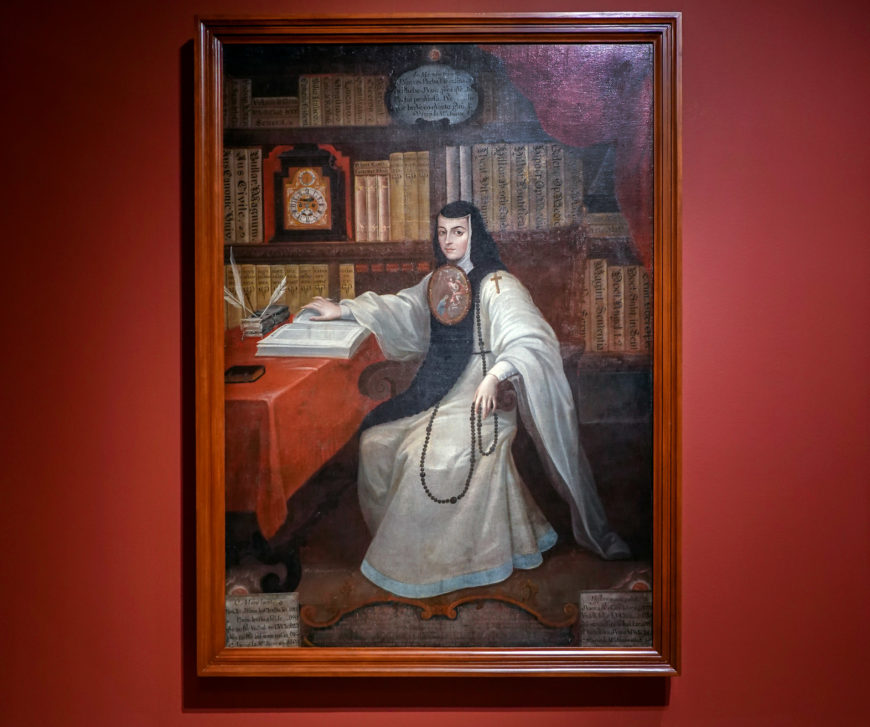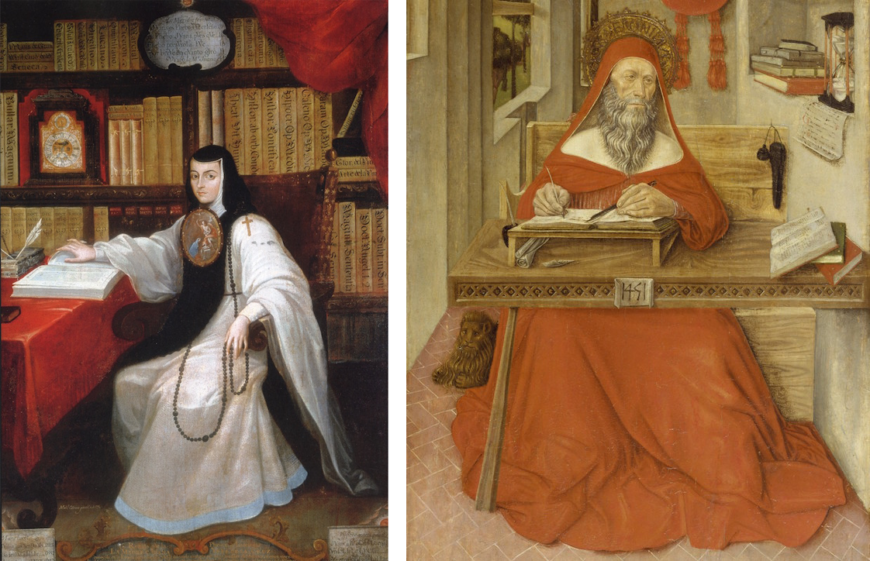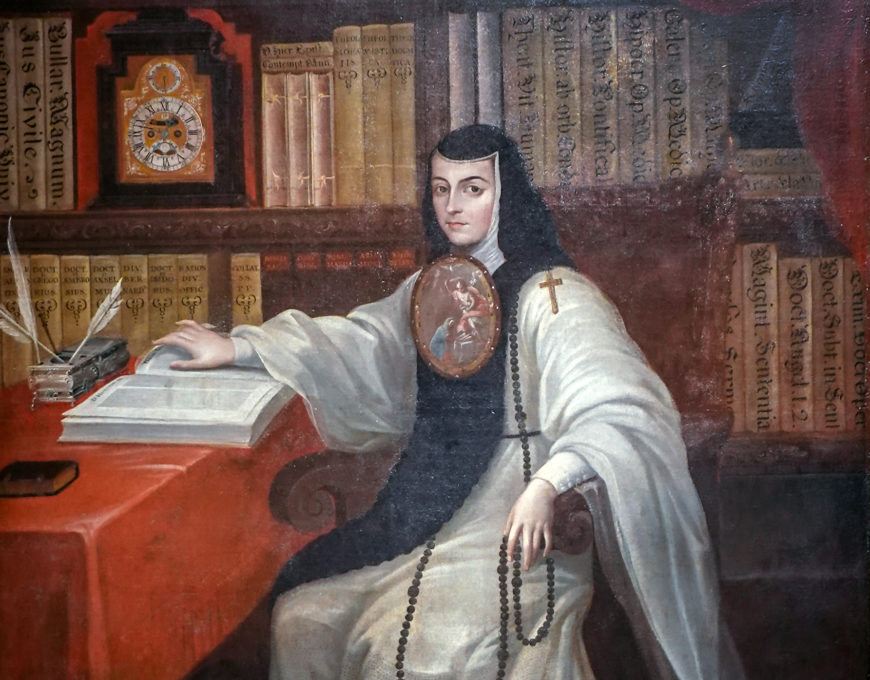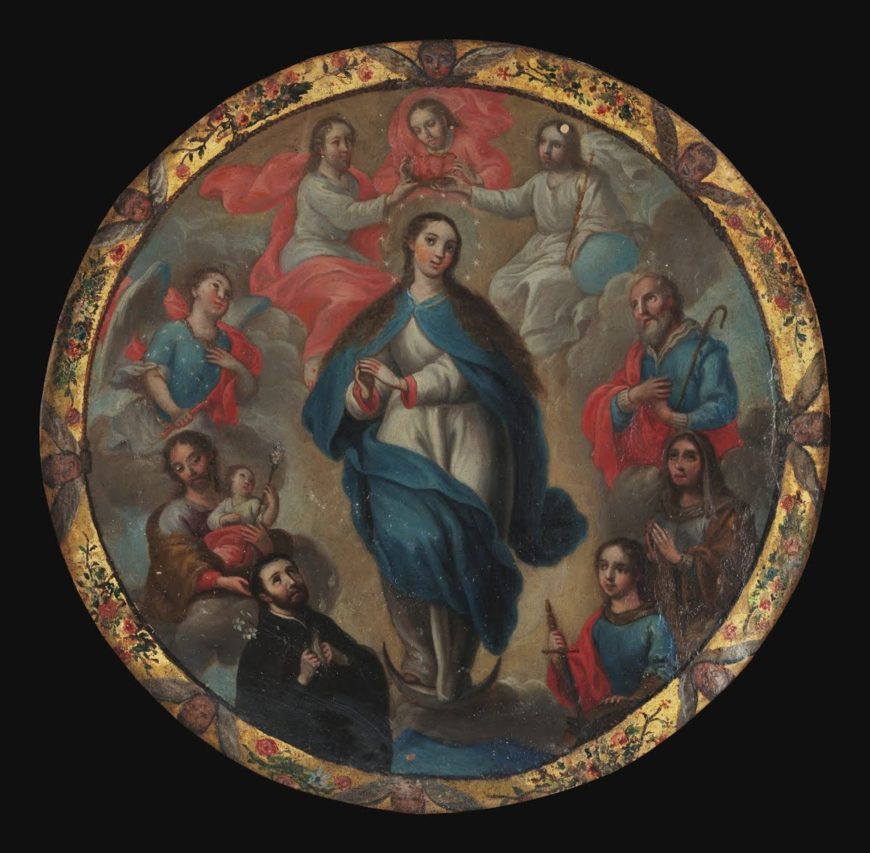
Miguel Cabrera, Portrait of Sor Juana Inés de la Cruz, c. 1750, oil on canvas (Museo Nacional de Historia, Castillo de Chapultepec, Mexico; photo: Lauren Kilroy-Ewbank, CC BY-NC-SA 2.0)
Miguel Cabrera’s posthumous portrait of sor Juana Inés de la Cruz (1648–1695) is a famous depiction of the esteemed Mexican nun and writer. Considered the first feminist of the Americas, sor Juana lived as a nun of the Jeronymite order (named for St. Jerome) in seventeenth-century Mexico (then part of the Spanish viceroyalty of New Spain). Rather than marry, she chose to become a nun so she could pursue her intellectual interests. She corresponded with scientists, theologians, and other literary intellectuals in Mexico and abroad. She wrote poetry and plays that became internationally famous, and even engaged in theological debates.
Her life
Born to a creole family in 1648, sor Juana was a child prodigy. At the age of fifteen, she amazed people at court by excelling at an oral exam that tested her knowledge of physics, philosophy, theology, and mathematics.
She came to live as a lady in waiting in the house of the viceroy (the substitute or representative for the Spanish king in Mexico). Shortly afterwards, she chose to become a nun instead of marry. She entered the Carmelite convent in 1667, but left a year later to join the Jeronymite order in 1669—and in the process gained intellectual freedom. The Jeronymite order allowed her to host intellectual gatherings and live a comfortable life.
In 1690 she became involved in an ecclesiastical dispute between the bishops of Mexico City and Puebla. She responded to the criticism she received as a woman writer, which culminated in one of her most famous works: The Answer (La respuesta, 1691). This work defended her right as a woman to write and to be a scholar. At one point she claimed that:
I do not study in order to write, nor far less in order to teach (which would be boundless arrogance in me), but simply to see whether by studying I may become less ignorant. This is my answer, and these are my feelings. . . .
Despite her eloquent defense, the Church forced her to relinquish her literary pursuits and even her library. When she sold her library and musical and scientific instruments, she wrote a document that renounced her learning, which ended with “I, Sor Juana Inés de la Cruz, the worst in the world,” signed in her own blood. After giving up her intellectual pursuits, she cared for the infirm during an epidemic but she fell sick and passed away.

Left: Miguel Cabrera, Portrait of Sor Juana Inés de la Cruz, c. 1750, oil on canvas (Museo Nacional de Historia, Castillo de Chapultepec, Mexico); Right: Antonio da Fabriano II, Saint Jerome in his Study, 1451, tempera, oil (?) and gold leaf on wood panel, 34 13/16 x 20 13/16″ (The Walters Art Museum)
An intellectual
Miguel Cabrera positions sor Juana in such a way that the portrait emphasizes her status as an intellectual. He never actually met sor Juana, so he likely based his image of her on earlier portraits of her, possibly even some self-portraits. Cabrera also likely modeled this painting on images of male scholars seated at their desks. Most importantly, he possibly found inspiration in depictions of St. Jerome, the patron saint of sor Juana’s religious order. Images often portray St. Jerome seated at a desk within a study, surrounded by books and instruments of learning.

Miguel Cabrera, Portrait of Sor Juana Inés de la Cruz (detail), c. 1750, oil on canvas (Museo Nacional de Historia, Castillo de Chapultepec, Mexico; photo: Lauren Kilroy-Ewbank, CC BY-NC-SA 2.0)
…and a nun
In many ways this is a typical nun portrait of eighteenth-century Mexico. Sor Juana wears the habit of her religious order, the Jeronymites. She also wears an escudo de monja, or nun’s badge, on her chest underneath her chin. Escudos de monja were often painted, occasionally woven, and they usually displayed the Virgin Mary. Sor Juana’s escudo shows the Annunciation, the moment in which the archangel Gabriel informs Mary that she will bear the son of God. Her left hand toys with a rosary, while she turns a page of an open book with her right hand. The book is a text by St. Jerome, the saint after whom her religious order was named.
Cabrera’s portrait differs from other nun portraits in several important ways. She looks towards us, her gaze direct and assertive, as she sits at a desk, surrounded by her library and instruments of learning. The library here includes books on philosophy, natural science, theology, mythology, and history, and so it reflects the types of works in sor Juana’s own library. Writing implements rest on the table, a clear allusion to sor Juana’s written works and intellectual pursuits.
The rosary—a sign of her religious life—is juxtaposed with items signifying her intellectual life. The books, the desk, the quills and inkwell aid in conveying her intellectual status. The red curtain, common in elite portraiture of this period, also confers upon her a high status.


